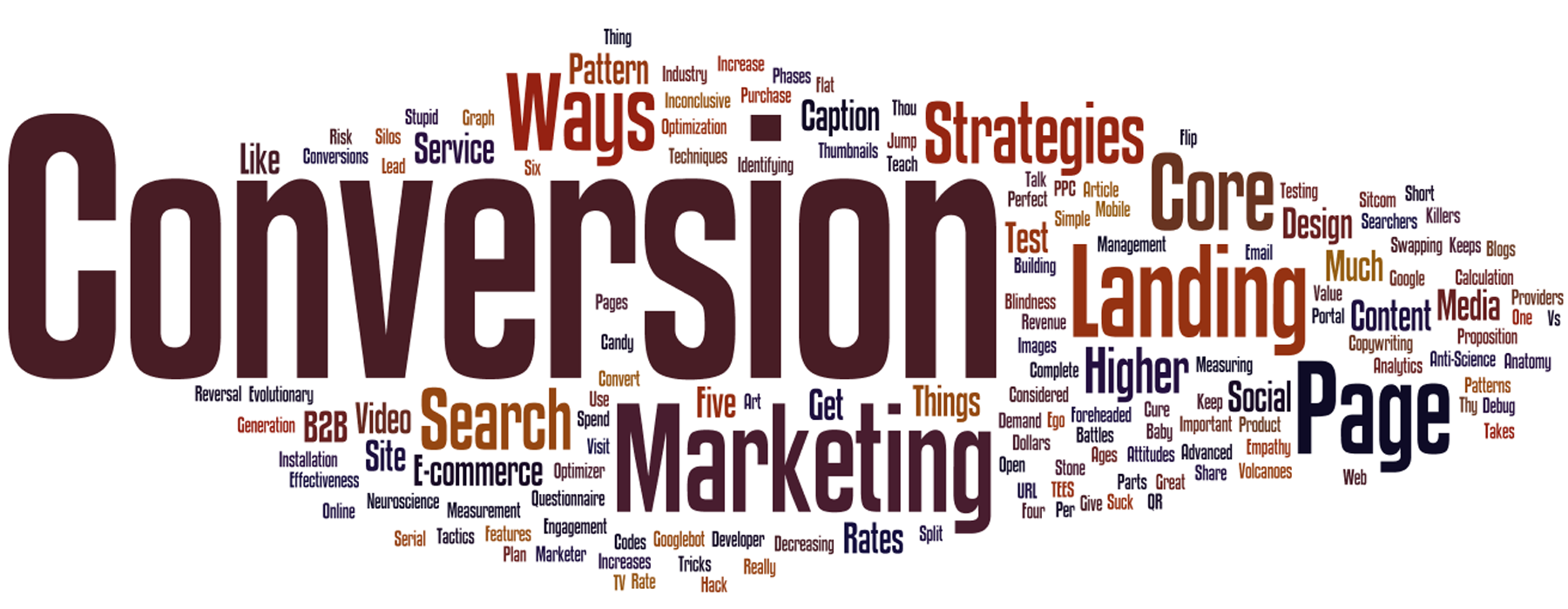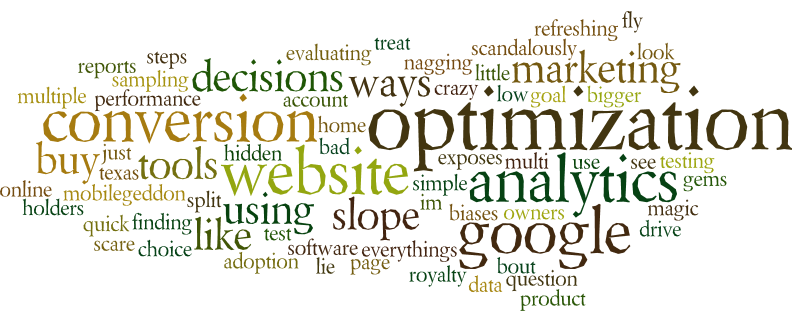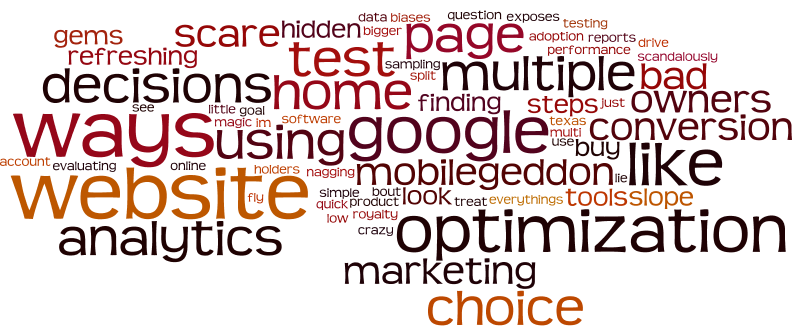2 ways word clouds help you optimize
Don't ignore what's truly important to your visitors. Columnist Brian Massey walks you through two ways to use words clouds with transcripts to help you understand your customers' input and know what they value.
 The key to successful A/B testing on your site is picking the right things to test. One of the most helpful sources of testing hypotheses is transcripts of customer conversations. There are a number of sources of transcripts, such as those from live chat, phone calls and more, that help you understand the primal questions that your visitors have.
The key to successful A/B testing on your site is picking the right things to test. One of the most helpful sources of testing hypotheses is transcripts of customer conversations. There are a number of sources of transcripts, such as those from live chat, phone calls and more, that help you understand the primal questions that your visitors have.
Below, I present two ways to pre-process transcripts — Combining Words and Weighting — that will help you understand what language is truly important.
First, here’s an example of how words can reveal conversion-improving ideas.
How the word cloud saved us
We had completed three rounds of A/B tests for Discount Catholic Products and had not been able to significantly increase revenue per visit for them. We struggled to find changes that appealed to the two largest segments of buyers: those who checked out as guests and those who had an account. This included clearer signals in the cart, larger product images, and the addition of testimonials.
The Conversion Scientist that was assigned to the project decided that our analysis of the site had missed something that was critical to the target audience of Discount Catholic Products. So we went looking for a way to find out what the prospects and customers valued.
Fortunately, the management team at Discount Catholic Products solicited feedback from customers using a simple Survey Monkey survey. This provided an interesting insight: that faith is very important to these buyers. Here’s a word cloud of the input from the surveys:
Given that the word “faith” appears so frequently in customer surveys, our Conversion Scientist developed a hypothesis: that the site should express the faith of the owners.
We know that it’s critical to imbue a website with the values of the business. We saw an opportunity to do that here.
The hypothesis was pretty simple. We tested adding a Bible verse to the pages of the site.
The results were fantastic. Clearly, visitors wanted to buy from a site that shared their values.
Examining the input of visitors and customers will result in powerful hypotheses, but it requires a combination of analysis and creativity. You can be creative and communicative and mathy all at the same time. In fact, you have to.
You might be surprised at the number of sources of this data you have access to.
Types of transcripts and how to use them
Live chat transcripts
A certain segment of your visitors will appreciate live chat. It’s most frequently used when the website content has left their questions unanswered. It’s also used by relational buyers, who see searching and shopping as a cost of the transaction.
Live chat offers a shortcut for them. Your spontaneous personas will also appreciate live chat as they are impatient to take action.
The transcripts of these chats are a goldmine of questions — queries that aren’t vividly apparent on your site. As such, they can provide hypotheses on what to add to the site to increase conversion rates, sales and leads.
Product reviews
What do customers find significant about your products? Reviews offer this insight. What’s important to those who have bought is likewise significant to those who are in the shopping process.
Read your product reviews to find themes of happy and unhappy visitors. These will lead to powerful hypotheses.
Phone call transcripts
Callers make up another segment of your audience. This segment is often stereotyped as being older visitors and the least trusting.
Like live chat, relational buyers will be more likely to pick up the phone when they have trouble, or just want to ensure that you are a credible website.
Listening in on a number of calls can be very helpful, but it’s quite time-consuming. If you interview the call center employees, they can tell you what the most common objections are that they handle.
Both of these techniques suffer from biases, however. Our minds don’t tally up issues efficiently when listening to calls; we’ll focus on the most emotional or recent issues handled. If you ask a salesperson what is most important to their prospects, they’ll most likely report issues from their most recent encounters.
If you can have calls transcribed, you can do some simple analysis to guide your hypotheses.
Survey results
Smart businesses solicit feedback from customers and prospects. This data source suffers from two biases. First, self-reported data is notoriously error prone. Humans are excellent at making up stories to rationalize why they did or did not do something. These rationalizations often mask the true reason they took action.
The second bias occurs from the design of surveys. Surveys are easier to tabulate when they offer fixed choices from which the survey-taker can choose. However, this limits the fidelity of the data collected.
For example, a survey may ask a visitor to choose what industry their business is in, offering a list. This forces the respondent to describe themselves in your terminology, not theirs. It is also very unsatisfying if the category they put themselves in isn’t on your list. This can reduce survey completion rates. The same effect happens on lead generation forms, reducing conversion rates.
Be sure to offer open-ended language in your surveys to really understand how your prospects and customers talk about themselves. Then incorporate this language into your marketing. Test it, of course.
A simple way to analyze lots of words
I’ve used the incredibly helpful online service Wordle before in this column to analyze the topics I talk about.

The word cloud I used to see what topics my readers are interested in.
Wordle takes a lot of words and counts the occurrence of the most commonly used words and displays a word cloud. The most common words are larger, and the least common ones are smaller. At a glance, you get an idea of the concepts that your prospects and customers are talking about.
With a little more work, it’s easy to clean up and weight your data for better analysis.
Pre-processing the transcripts
In raw form, a transcript of any source may obscure key concepts that your visitors are using. By preprocessing the source transcripts a bit, you can better zero in on what your visitors care about.
Combining terms
Following is a Wordle for a business that provides quotes on mobile offices online. These mobile offices are most often seen at construction sites and the like. A field in the lead-generation form offered an open-ended question: “Any specific requirements that we should know about?”
Here’s the word cloud for responses to this question.
One of the insights from this word cloud is the frequency of the terms “bathroom” and “restroom.” Clearly, this is an issue that is important to these prospects.
It would be helpful in this case to combine the terms “restroom” and “bathroom.” This is done by a simple search and replace in the text. We also can combine plurals, by replacing every occurrence of “offices” with “office.”
The occurrence of “air conditioning” can be combined into one word “AC” or “HVAC” or “airconditioning” for the analysis. Then the term “heat” can be changed as well to aggregate these.
This becomes a cyclical process, but will result in a clear understanding of your visitors’ important concepts.
Weighting results
Sometimes we want to give certain text more weight. In my evaluation of column titles from 2015, I wanted to give more weight to titles that had more views. In this case, I wanted the words in my most popular column titles to be counted extra.
For my analysis, I simply duplicated the column titles a number of times relative to their popularity, so that the words in the most popular title appeared more frequently in my text file.
Here is the word cloud for my “weighted” column list.
In this version, terms like “mobilegeddon” are more prominent. I also see that readers like to know “ways” of doing things. I can use this to modify my subjects and headings.
This is a brute force method, and Wordle offers a more elegant solution. In advanced mode, you can include a weighting with words to get a weighted result. With a little parsing in Excel, I generated a list of words used in the titles of my 2016 columns so far and weighted them by views.
These word clouds help you identify the things that are important to your visitors. You, the marketer, must apply the creativity to generate hypotheses from what these word clouds mean. They will help you think outside of the numbers.
Contributing authors are invited to create content for MarTech and are chosen for their expertise and contribution to the search community. Our contributors work under the oversight of the editorial staff and contributions are checked for quality and relevance to our readers. MarTech is owned by Semrush. Contributor was not asked to make any direct or indirect mentions of Semrush. The opinions they express are their own.
Related stories






